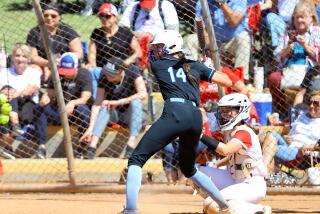U.S. OLYMPIC FESTIVAL : How the West Was Won : In Softball, 3 of 4 Directions Point to the Supremacy of Southern California
- Share via
RALEIGH, N.C. — To understand the women’s softball competition here at the U.S. Olympic Festival, what you needed to know could always be found in parentheses.
North, South, East and West meant little to anyone other than those locals among the crowd who came out to cheer anyone wearing the green jersey of the South, regardless of from where the players hailed.
Even the announcers sometimes seemed confused as to what to call the gold-medal winning West (Southern California Invasion), the silver-medalist East (Hi-Ho Brakettes of Stratford, Conn.), the bronze-medalist South (Orange County Majestics) or the North (Los Angeles Diamonds), which finished fourth.
Most of the 3,000 athletes here participating in 34 sports were at least roughly divided according to region.
But in women’s softball, it was not even close, as three of the four teams here--selected for being the top four finishers at the 1986 American Softball Assn. 18-and-over national championships--hailed from greater Los Angeles.
As Liz Mizera of Garden Grove, a first-team All-America shortstop at NCAA champion Texas A&M; and a player on the Majestics saw it, “We could have just had it in California and had the East come out.”
In the gold-medal game Wednesday night, Susan LeFebvre, the former Cal State Fullerton star, led the Invasion, pitching a five-hitter in a 5-0 victory over the Brakettes. She improved her Festival record to 4-0.
In the bronze-medal game, the Majestics’ Dana Ramos of Montebello--a former Fountain Valley High, Golden West College and Cal Poly Pomona player--delivered a two-out single in the ninth inning, driving in Suzy Brazney of Huntington Beach, who had led off with a walk and been sacrificed to second, for a 1-0 victory over the Diamonds.
The hit broke up a pitching duel between former Cal State Fullerton star Connie Clark, who allowed three hits and took the loss, and Michele Granger of Placentia, who pitched a two-hit shutout.
The victory was the first of the Festival for Granger, the 17-year-old national-record setting pitcher from Valencia High. Exhausted after leading the United States to the title of the Junior Fast Pitch World Championships in Oklahoma City Saturday, Granger was 0-2 with a 3.50 ERA in two games before Wednesday night.
Within and among the three Southern California teams, some interesting combinations and confrontations emerged during the competition.
Granger pitches for the Majestics, and her catcher is Brazney, a 25-year-old former Cal Poly Pomona star. But during the past high school season, they encountered each other as opponents--Granger as a Valencia High pitcher and Brazney as the coach of the La Quinta High team.
The Los Angeles Diamonds make teammates out of former Cal State Fullerton pitcher Connie Clark and Janice Parks, whose UCLA team helped eliminate Fullerton from the softball College World Series this year.
Though there are hardly any hard and fast rules to the makeup of the Southland teams, some features stand out.
The Majestics are largely current and former Cal Poly Pomona players and are coached by Carol Spanks and Shirley Topley, both of Tustin. Among the Pomona players on the team are Denise Correa of Irvine, Kim Nutter of Huntington Beach and Kristin Rokosz of Fullerton. But added in are Granger and Texas A&M;’s Mizera.
The Diamonds are largely a Cal State Fullerton alumni club. Among the players with Fullerton connections are Clark, JoAnn Ferrieri of Orange, Carey Hess of Anaheim and Charis Monroe of Huntington Beach.
The Invasion is a bit harder to figure, distinguished, perhaps, largely by the fact that most of its players are in their mid-20s rather than college-aged. Among them are LeFebvre, 23, and Donna McElrea of Tustin, 24.
“There’s so much talent around, everybody just has to find a place to play,” Topley said.
Twelve of the 18 players on the U.S. Pan American Games team are here, and will move on to that competition immediately. And in late August, these four teams may meet again, as the finalists in the 1987 ASA national championships.
More to Read
Go beyond the scoreboard
Get the latest on L.A.'s teams in the daily Sports Report newsletter.
You may occasionally receive promotional content from the Los Angeles Times.






